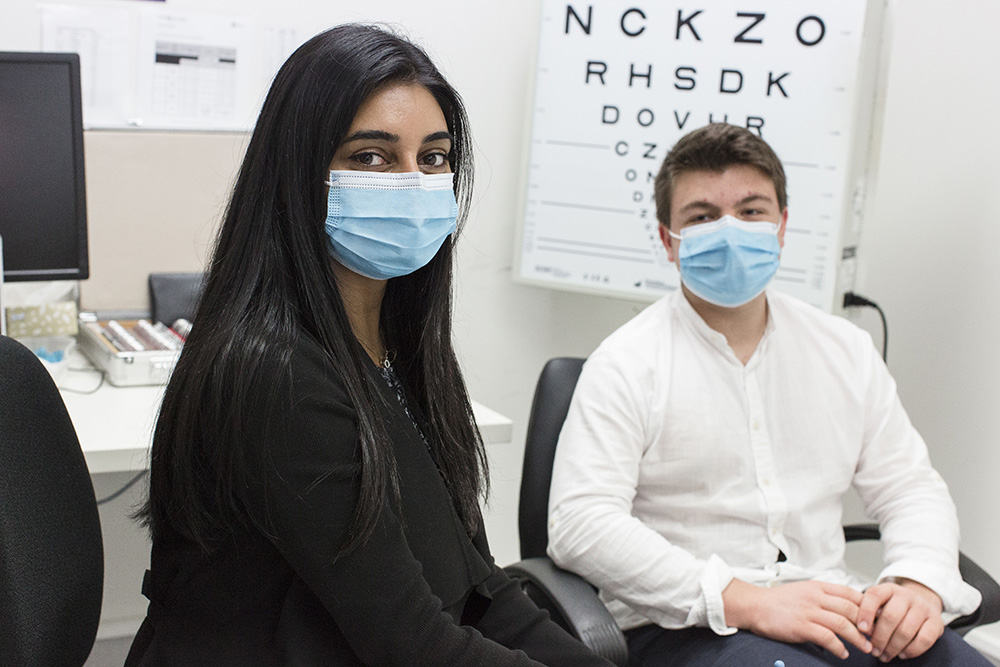Stories
Daniel defines his future
Daniel is not letting vision loss define his life and is helping CERA researchers unravel the genetic puzzle of inherited retinal disease.
When he was a kid, Daniel’s vision didn’t bother him too much.
“At first, my teachers thought I was just avoiding work when I couldn’t see the whiteboard,” Daniel recounts.
“When I was nine or 10, I was given prescription glasses, but they were horribly inappropriate and only really worked for reading.”
Daniel, now 15, has a condition called Stargardt’s disease, which creates a blur over his central field of vision.
Sometimes known as juvenile macular degeneration, Stargardt’s is a condition of the eye that leads to low vision.
The cause is locked within Daniel’s DNA.
As the instruction manual for the body, deoxyribonucleic acid, more commonly known as DNA, is responsible for all kinds of tasks within the eye.
From producing new cells to clearing the waste left behind by sight, DNA guides the delicate processes that allow us to see.
For Daniel and other people with Stargardt’s disease, a specific gene mutation acts like a typo in those instructions.
Instead of sweeping away the by-products of sight, proteins in the eye allow small flecks of material to build up across the macula that interferes with central vision.
“If ‘normal’ vision is a clear and developed image, mine is like you’ve just loaded up the webpage: it’s blurry,” says Daniel.
Inherited retinal disease
Inherited retinal diseases (IRDs) – of which Stargardt’s is just one – are the most common cause of legal blindness among working-age adults.
About 16,000 Australians experience IRDs in some form, but understanding the full scope and impact of them is a huge project.
“We look at the individual and their vision, especially as it changes over time; that gives us a starting point,” says Bhaj Grewal, Clinical Trial Coordinator in CERA’s Retinal Gene Therapy Unit.
“We can compare what we see in their genetic results, and place that side-by-side with genetic information from their parents, siblings and other family members.
“By zooming in to that level of detail we can build a much richer picture of inherited retinal disease more broadly.”
Research has made enormous leaps in mapping the hundreds of thousands of genes that make up DNA.
That instruction manual, however, still contains mysteries – which is why CERA research tackles IRDs from multiple perspectives, including an extensive natural history study with global reach.
“By collecting as much information as possible, we begin to build a picture of what happens within the eye leading to these conditions,” Bhaj explains.
“If we can identify the gene mutations responsible for vision loss, we can focus on understanding that series of events – which brings us closer to being able to treat, cure or even prevent IRDs.”

Through his eyes
Like many people with an IRD, Daniel’s vision has changed over the years.
“I’ve become more aware, as my sight has gotten worse, that it has a significant impact on how I engage with the world,” he says.
For Daniel, the main consequence of Stargardt’s is the absence of detail in his central field of vision – although, notably, his peripheral vision is more than sharp enough for after-school boxing twice a week.
The bigger challenge is a social one.
“When I’m walking past someone, it takes until the last minute to recognise them – when I’m close enough to actually distinguish their face,” he says.
“I worry that I’ve insulted them or come across as rude.
“It does make me feel more alienated and disconnected from others.”
Expectations and reality
In adjusting to his vision and diagnosis, Daniel has come to expect a lack of awareness from the people around him.
“Even when I’ve explained what I require, like a digital exam paper or a larger print out, I’m still counting on others to meet those needs – some people are just uninformed, or don’t get it.”
Since joining CERA’s investigations of IRDs, Daniel’s knowledge of his condition has grown, and alongside it he’s learned to advocate for his own needs.
“I used to be pretty incurious – since beginning the clinical trial, I’ve gained so much knowledge relating to my condition and how it affects me,” he says.
“My vision hasn’t taken over my life, which is honestly my ideal state.
“It’s an immutable part of me, but it doesn’t define me.”
Focus on the future
With the strength and support of his family, especially parents Vince and Sara, Daniel is prepared to tackle the future challenges of his condition.
“So much of my experience is fundamentally forged through social relations, rather than putting emphasis on my vision,” Daniel explains.
“I know that I can reach my fullest potential with the empowerment of the people closest to me.”
Navigating his changing vision is just one aspect of Daniel’s life, and he approaches it with the same curiosity as he does his STEM (Science Technology Engineering and Mathematics) school subjects.
“It’s exciting to me, following instincts to understand and relate concepts to each other,” Daniel says.
“Engineering is like a symphony of my interests in mathematics, physics, and chemistry.”
The drive to understand action and consequence is part of Daniel’s motivation to participate in research and contribute a piece to the IRD puzzle.
“Yes, my vision is declining, and we have to really bear out the effects of the treatment, but I hope it stagnates – that the rate of deterioration slows.”
Thanks to people like Daniel, a growing library of genetic data is unravelling the mechanics of these conditions – putting new treatments within reach.
This article first appeared in Visionary magazine – Spring 2023.
